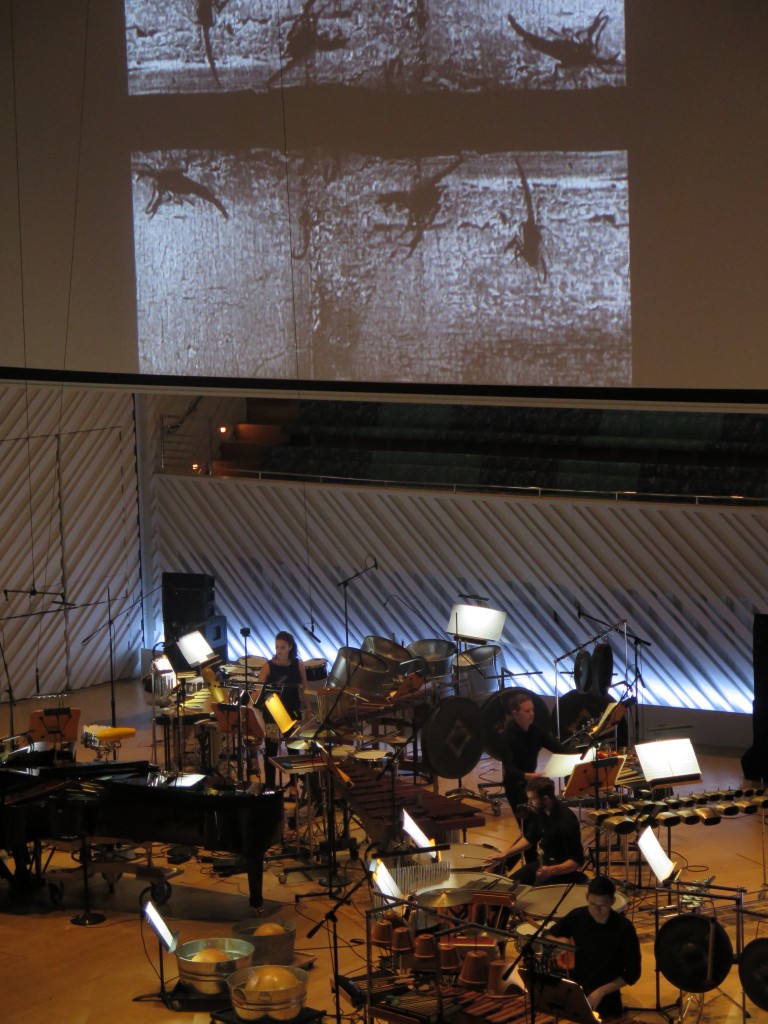New World Percussion Consort scratches and soothes with music of Matelon and Bryars

The New World Percussion Consort performed Martin Matelon’s “…del color a la materia…” Saturday night in Miami Beach. Photo: Craig Hall
A warm, glowing sound rose from the ensemble on stage at New World Center, as velvety tones and yearning harmonies filled the hall.
Could this really be a percussion concert?
The orchestral section that specializes in struck instruments moved from the back of the stage to the front Saturday for the New World Symphony’s annual concert devoted to percussion instruments. As in the past, the Miami Beach concert revealed a vast range of capabilities for what’s certainly the least-known section of the orchestra, one with instruments many audience members probably couldn’t name either by sight or sound.
The concert, conducted by Michael Linville, the orchestra’s dean of chamber music, opened with the U.S. premiere of a 2004 work called New York by the English composer Gavin Bryars. Named for a village in England, not the U.S. city, the work called for six percussionists, backed by a small orchestra, performing on a series of marimbas, xylophones and vibraphones.
Mastery of the mallet instruments is one of the marks of the orchestral percussionist, and the musicians’ extreme skill on them was apparent throughout. Holding mallets in both hands—and sometimes working with two mallets in each—they played rapid runs and patterns as well as complex but soft-edged tremolos, usually while attending to more than one instrument.
The music was a sort of minimalism, with repeated patterns of notes, a generally tonal vocabulary and abrupt harmonic changes that moved the note patterns forward. The tone was mysterious, wistful, nighttime and faintly jazzy (the composer had been a jazz bass player).
Warm and inviting, the work had a pensive, finely paced middle section, as an oboe floated tones above the pulsing percussion instruments. Sharper, more assertive rapping tones followed, as the music gained energy. And it ended in a mood of peace and melancholy, with spare violin notes and glassy dissonances.
The second half was devoted to “…del color a la materia…” by Martín Matalon. The Argentine composer, a Juilliard graduate who now lives in France, was present in the audience.
The music was composed to accompany scenes from Luis Buñuel’s film L’Age d’Or (The Golden Age), a 1930 surrealist film that tells the story of a man and woman attempting to pursue a physical relationship while being thwarted by society, with jabs taken at the upper classes and the Catholic church.
The complexity of the percussionists’ job was apparent from the equipment surrounding each of the six musicians—mallet instruments, gongs, cymbals, snare drums and a globe-spanning series of other instruments intended to be struck, including what appeared to be a string of upside-down flower pots. Also on stage was the pianist Thomas Steigerwald, who ably performed his complex part.
Projected on a screen above the stage, the film was a series of bizarre vignettes—scenes of scorpions fighting; an exhausted man staggering across a rocky landscape; the hero and heroine trying to make love as a group of public officials break up the scene and arrest him; his escape and sudden assault of a blind man; her discovery of a cow on her elegant bed; his defiant heaving of establishment symbols out of a window, including a Catholic bishop.
The music that accompanied all this was more frankly percussive and aggressive than the veiled, nighttime tones of the first half. Wild drum riffs, broken-glass cascades on the piano, eerie runs on the marimba and a vast range of hollow knocks, hisses and scratches from the intercontinental variety of instruments on stage accompanied the strange scenes projected on the screen. The weird, menacing, anarchic music certainly fit the film, but that wasn’t enough to make the work entirely hold together.
Although the film has spoken dialogue, it was silent at the concert and without subtitles, one of the reasons the 40-minute work was sometimes hard going. Neither music nor film contributed enough to the performance. The music would have been difficult to assimilate entirely on its own, yet the film—stripped of dialogue and reduced to a few scenes—lacked the heft to hold up its end.
Posted in Performances
Leave a Comment
Sun Sep 30, 2018
at 12:32 pm
No Comments